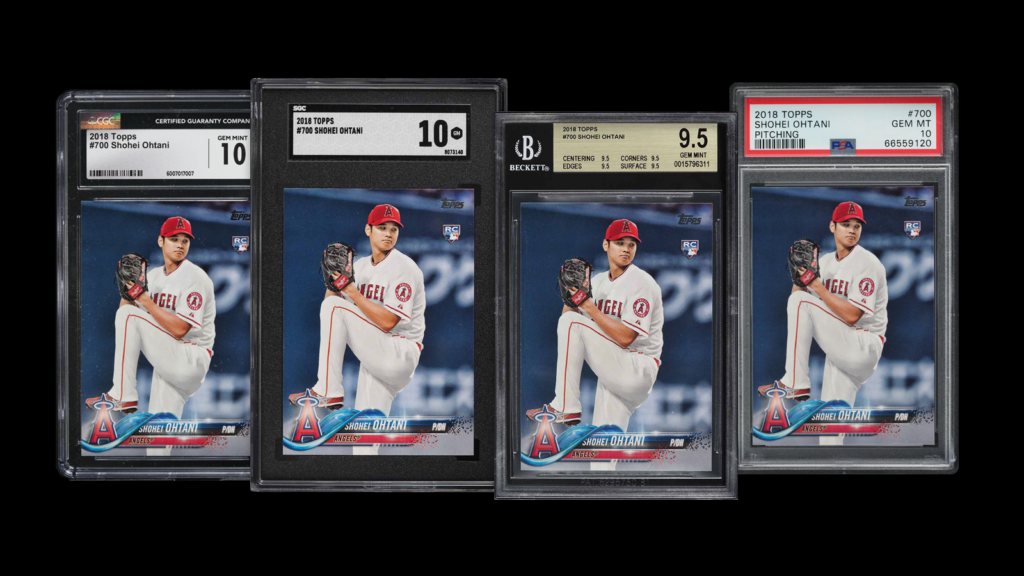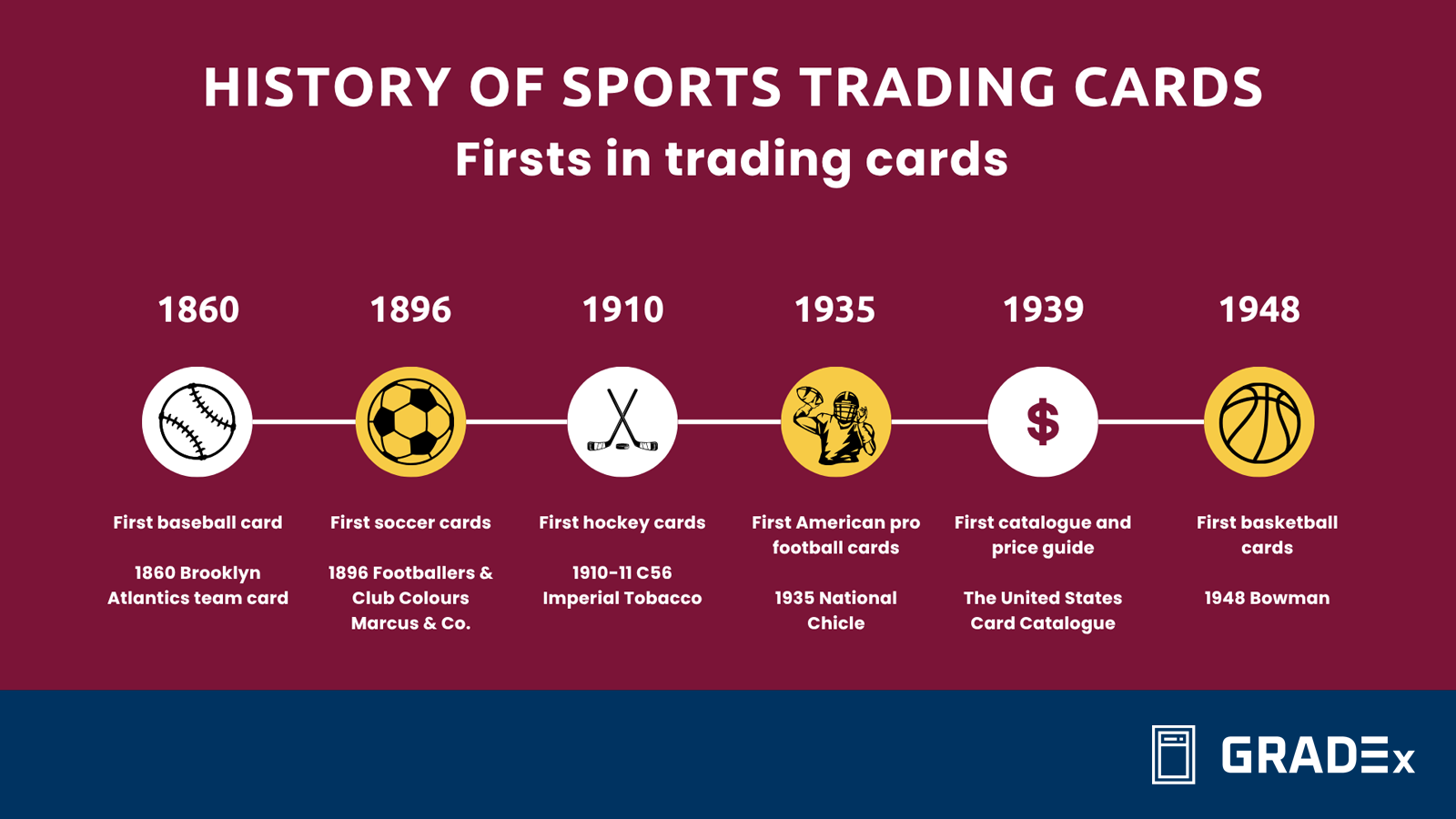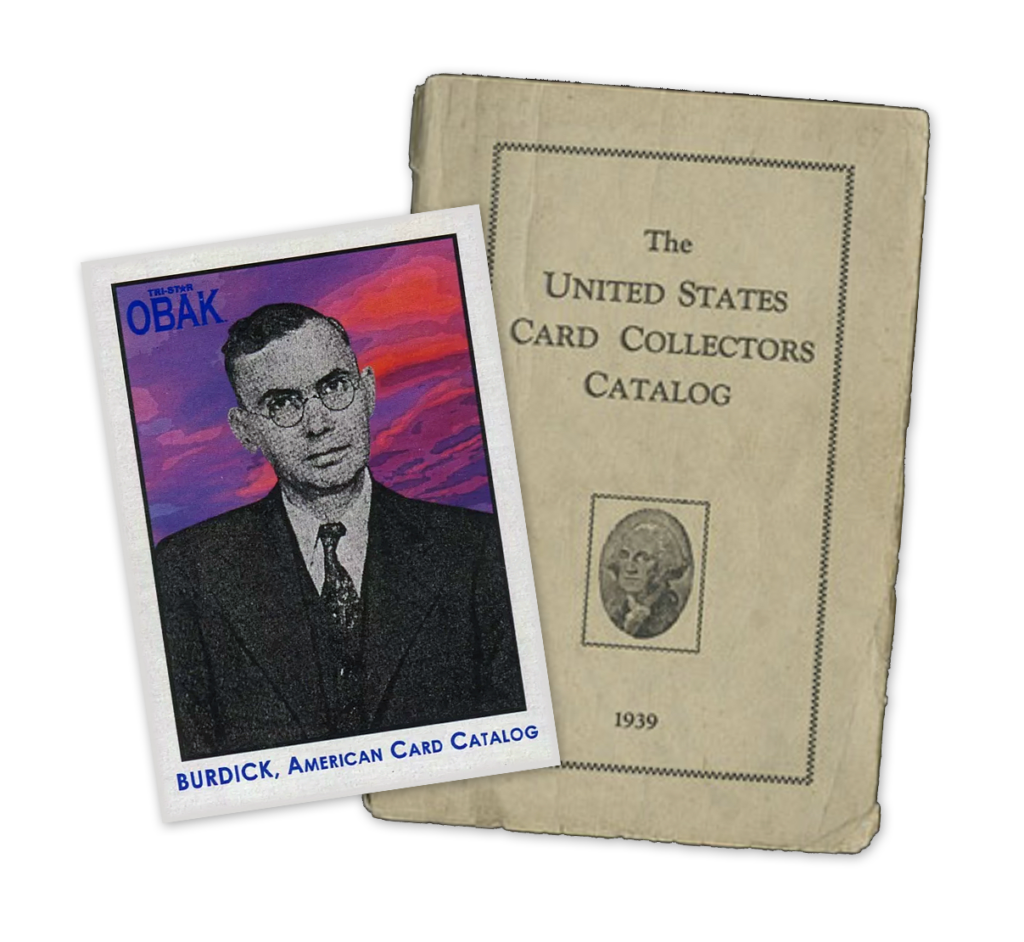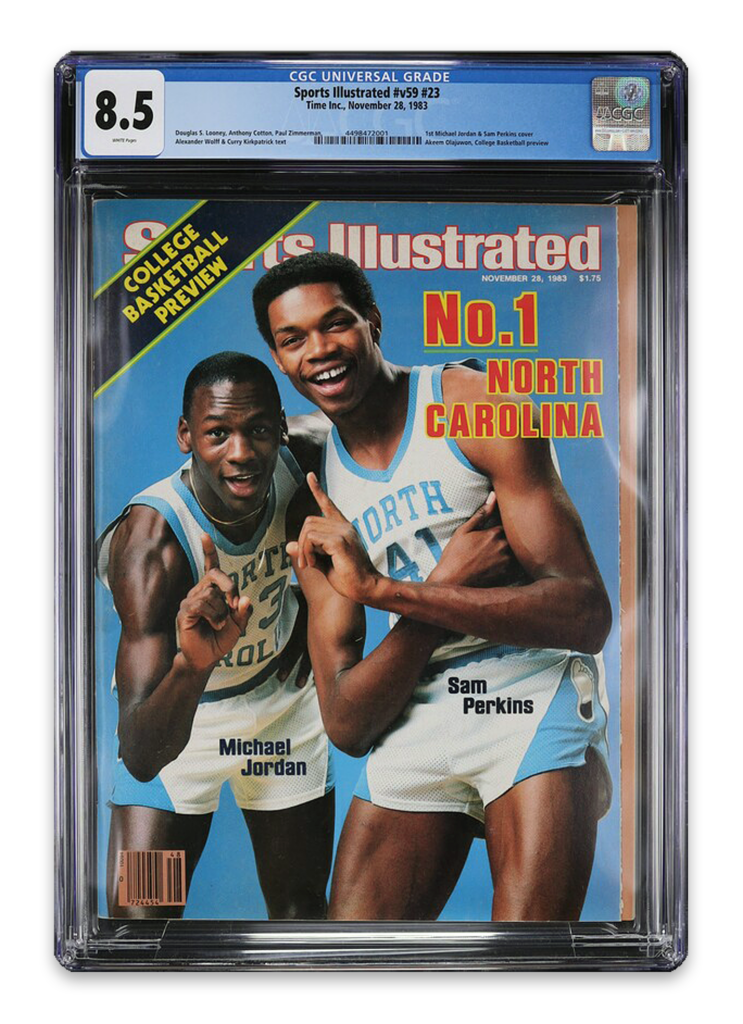Introduction
You may be wondering about the title of this section, specifically the term “ongoing history”. Seems like a contradiction of terms, doesn’t it? However, it’s meant to reflect the fact this resource will tap into the ongoing research of the past and will be a “living document” so to speak.
The goal is to gather information from a wide range of resources ranging from printed material to consulting with veteran collectors who have lived through a number of collecting eras… from a time when adults kept their card-collecting habits quiet because they didn’t want to be embarrassed by those who believed it was largely a child’s venture, to the modern era where thousands of people, young and old, men and women, gather to celebrate the hobby and their endless pursuit of completing sets and expanding their collections. Your input is inexhaustible and we want to take full advantage of this.
In this chapter, we will cover many of the significant events of the last 160 years of sports collecting. We will traverse the major eras including…
Tobacco Era (1860-1945), Bubble Gum Era (1946-1979), ’80s & ’90s: Boom & Bust Era (1980-1999), and Modern Era (2000-present).
Before we start, it should be noted that non-sport and entertainment trading cards have a rich history that actually predates sports cards, originating in the mid-19th century as advertising tools featuring various subjects like actors, historical figures, animals, flags and scenic views. Notable early examples include the Allen & Ginter series from the 1880s, which popularized collecting and trading cards by being included in cigarette packs.
Trading cards even pre-date comic books, emerging in the mid-19th century, while comic books gained popularity in the early 20th century.
Pre-War / Tobacco Era (1860s-1945)
Early History
This is a condensed history of sports trading cards, covering many significant events from the past 160 years of collecting. While not exhaustive, it highlights key moments and trends.
Cards produced before 1946 are commonly known as “Pre-War” or “Tobacco” cards. Baseball cards have the longest and richest history in the sports trading card industry, as baseball was the first sport to become widely professionalized. Regardless of the sport, all trading cards were often referred to as “baseball cards,” reflecting baseball’s dominance in the hobby. It should be noted that when the concept of “trading cards” was first conceived, they were always utilized to help sell other products such as cigarettes and candy. Cards were never distributed as a product onto itself. And while some folks did embark on collecting and saving these cards, they were in the minority. The majority were likely discarded (no pun intended) because very few anticipated they would retain any value. The concept of a secondary market was a foreign one.
In this overview, we will reference several key moments in the baseball card industry, as they are well documented. However, many other sports experienced similar market swings and challenges. We will also touch on the first cards and sets of other major sports introduced during this era, including basketball, American football, hockey, soccer (or proper football), the Olympics, boxing, and more.
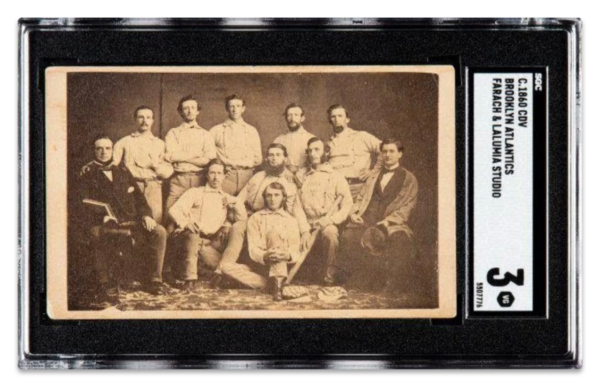
The first known baseball card, and sports card in general, is believed to be from 1860. It features the players of an amateur club called the Brooklyn Atlantics. This 1860 Brooklyn Atlantics baseball card, a carte de visite (CDV: a small photograph mounted on card stock, used as a souvenir), stands as the oldest known baseball card. Passed down through baseball player Archibald McMahon’s family, this rare piece was auctioned in 2015 and sold for $179,250 via Heritage Auctions. Another copy of the card is up for sale at Heritage Auctions (Photo credit, above: Heritage Auctions). The card holds great significance in both baseball and American history.
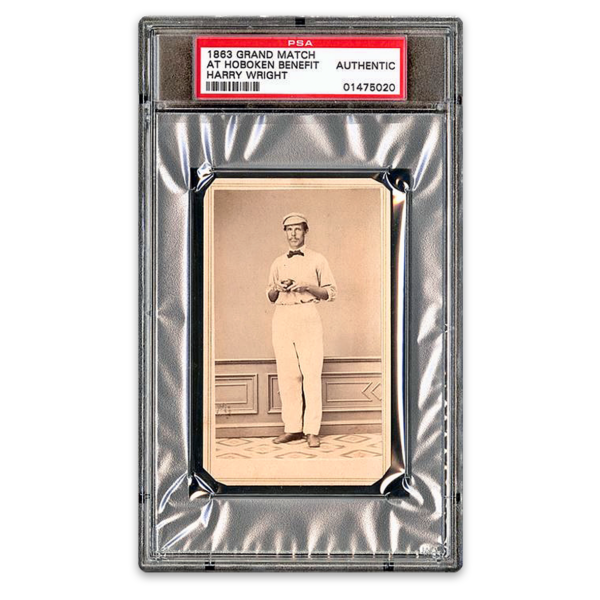
The first known card featuring a single player was produced in 1863, highlighting Harry Wright of the New York Knickerbockers. This card was created to promote a series of baseball and cricket events in New Jersey. Wright, a member of the Baseball Hall of Fame as a “Pioneer” and “Executive,” has been referred to as “the father of professional baseball” so it seems appropriate he is the first individual featured on a card. He had a passion for both cricket and baseball and actually moved from New York to Cincinnati in 1865 to pursue opportunities as a cricket player. He quickly fell back into baseball, however, and served as a pitcher and outfielder with the barnstorming Cincinnati Red Stockings until moving back east to create his own league, the National Association in 1871, where he played for and managed the Boston Red Stockings. That league was the precursor of the “National League” and, yes, that’s the same National League we know today (Photo credit above: PSAcard.com).

Also during this era, various businesses produced cards as promotional giveaways. The first known professional baseball card is believed to be a team card of the 1869 Cincinnati Red Stockings, who later became the Cincinnati Reds (Photo credit above: PSAcard.com).
The first sets of baseball cards featuring multiple cards and players were issued between 1885 and 1889. These cards were included as marketing premiums in various tobacco products, such as cigarettes and chewing tobacco. Tobacco companies quickly realized that sports cards were an excellent way to build brand loyalty. The 1887 Old Judge Cigarettes set is often credited as the first mainstream and nationally distributed baseball card set.
Trading cards featuring entertainment and historical figures also became popular during this time. Here is an example of a historically significant card from the 1889 Allen & Ginter World’s Sovereigns set:
Turn of the Century
Between 1909 and 1914, as baseball’s popularity surged, many businesses, including sporting goods stores, bakeries, magazines, and candy manufacturers, began producing baseball cards to promote their companies.
Side Note: In 1939, the first official trading card catalogue, The United States Card Collectors Catalogue, was published. It identified sets and established standardized names and codes for them. Many of these names, codes, classifications, and terms are still in use today. The catalogue was written and published by Jefferson Burdick. Learn more about Burdick here.
The first hockey cards were produced in 1911. This inaugural set featured the first card (or Rookie Card) of Hall-of-Fame goaltender Georges Vezina, after whom the NHL’s Vezina Trophy for Top Goaltender is named.
The T206 Set
One of the most important and widely collected sets of this era is the T206 set, introduced in 1909 and produced until 1911. This set remains highly sought after by collectors today. It was the first set to feature a large checklist of players (over 500) and included several variations, particularly different card backs.
The 1909 T206 Honus Wagner, often referred to as the “Holy Grail” of card collecting, is part of this iconic set. It is estimated that only 60 to 75 copies of the card remain in existence. Below are a series of videos exploring the mystery and allure surrounding this legendary card.
- Goldin Auctions (History of the T206 Wagner)
- Rally (Nun’s Wagner)
- Baseball Card Collector VHS video (5:00 mark, narrated by Mel Allen, 1989)
Effects of WWI and WWII
In 1914, World War I began, causing a severe slowdown in the production of sports cards due to a paper shortage. However, by 1919, after the war ended, sports cards regained popularity. In the realm of baseball cards, this resurgence was largely driven by the emergence and immense popularity of Babe Ruth. Ruth, who was rewriting the baseball record books as both a pitcher and a hitter in the 1920s and 1930s, became one of the most beloved figures in America.
The first American football cards were produced in 1935.
In 1939, the onset of World War II once again slowed sports card production until the war ended in 1945.
Sports trading cards from this era are now regarded as historical artifacts or even works of art.
Firsts in Card Collecting (estimated)
- First baseball cards: 1860
- First Olympic / multi-sport cards: 1887
- First college football card: 1888
- First soccer (proper football) cards: 1898
- First hockey cards: 1910
- First wrestling cards: 1912
- First golf cards: 1923
- First tennis cards: 1924
- First racing cards: 1931
- First professional American football cards: 1935
- First catalogue and price guide: 1939
- First basketball cards: 1948
As you can see by the above list, this era of sports cards laid the groundwork for the entire industry. Cards of all prominent sports were first introduced in this era. Also, it is important to keep in mind that many new sets are discovered all the time.
Post-War / Gum Era (1946-1980)
Bubble Gum & Topps
This era marked a significant transformation in sports cards, making them more like the ones we know and enjoy today. The consumer base changed, and so did the method of distribution. Chewing gum companies, rather than tobacco companies, became the main manufacturers of cards. Major players in the industry included Bowman Gum, Leaf, Fleer, and Topps, with most packs of cards including a piece of gum.
Cards became an important part of youth culture, with kids trading them in schoolyards across North America. These cards provided a strong connection to teams and players, and young people would study the photos and information on the back to learn about their heroes.
In 1949, Bowman Gum was the dominant manufacturer of baseball cards. They achieved this by signing top players to exclusive contracts, making it difficult for competitors to produce sets featuring baseball’s top players. In 1953, Bowman produced the first set using color photography. After the 1955 season, Topps purchased Bowman Gum and retired the brand, which remained inactive until its revival in 1989.
The first basketball cards were introduced in 1948. The 1951-52 Parkhurst hockey set was produced, becoming one of the landmark sets of the sport. In 1952, Topps produced its first standard baseball card set, designed by Topps vice-president Sy Berger. This set included the rare and iconic Mickey Mantle card. Mickey Mantle was the biggest baseball star in America throughout the 1950s and 1960s, and kids were clamoring to collect his cards.
From 1956 to 1980, Topps was the leading and sole major baseball card manufacturer, effectively holding a 25-year “exclusive” in the baseball card market. During this period, Topps was typically the only brand available for major sports cards, including baseball, football, basketball (in sporadic years), and hockey.
The Standard is Set
In 1957, Topps standardized their card dimensions to 2.5” x 3.5”, a size that remains the industry standard today.
Canada and Europe
From 1965 to 1980, Canadian baseball and hockey card collectors could purchase O-Pee-Chee cards, which were bilingual versions of Topps cards. O-Pee-Chee remained the preferred brand in Canada until the early 1990s.
In 1970, Panini, an Italian company, introduced their first officially licensed FIFA World Cup sticker album. This collectible quickly garnered a dedicated and loyal following, especially in Europe. Today, soccer cards and stickers are among the fastest-growing segments of the market.
Card Shows
Trading card shows began popping up around North America in the 1970s and helped develop the massive growth of the hobby in the 1980s and 1990s. These shows evolved from small local gatherings in community centers and school gymnasiums into major regional and national events that established market values, built community among collectors, and transformed card collecting from a childhood pastime into a serious adult hobby and investment market.
Prominent Sets from 1948-1979 (with key cards)
- 1948 Leaf baseball (Jackie Robinson)
- 1948-49 Leaf basketball (George Mikan)
- 1951 Bowman baseball (Mickey Mantle, Willie Mays)
- 1951-52 Parkhurst hockey (Gordie Howe, Maurice Richard, Terry Sawchuk)
- 1952 Topps baseball (Mickey Mantle, Willie Mays)
- 1952 Parkhurst CFL football (first CFL set)
- 1955-56 Parkhurst hockey (Fred Sasakamoose, first native NHL player)
- 1958 Topps football (Jim Brown)
- 1961-62 Fleer basketball (Wilt Chamberlain, Jerry West)
- 1965 Topps football (Joe Namath)
- 1966-67 Topps hockey (Bobby Orr)
- 1970 Topps football (O.J. Simpson)
- 1971-72 O-Pee-Chee / Topps hockey (Ken Dryden, Guy Lafleur, Marcel Dionne)
- 1973 Topps / O-Pee-Chee (Mike Schmidt w/ Ron Cey and John Hilton)
- 1979-80 O-Pee-Chee / Topps hockey (Wayne Gretzky)
1980s & 1990s Boom & Bust Era (1980-1999)
The ’80s
This era marks a significant period in the evolution of the sports card industry. It saw immense growth in popularity, establishing trading cards as a leading hobby for both boys and adults. The years were characterized by increased competition and innovation, as card manufacturers sought to outdo each other. This period also witnessed the emergence of trading card shops, with an estimated peak of 12,000 shops across North America. Trading card conventions became extremely popular during these years as well.
In 1984, Beckett Monthly, the first monthly baseball card price guide, was published. It remains one of the most respected sports card publications and news sources to this day. In 1986, Fleer introduced their first NBA basketball set since 1961-62. Although not overly popular at the time of release, the 1986 set became a must-have for collectors within a few years. Rookie cards from this set include those of Michael Jordan, Charles Barkley, Isaiah Thomas, Karl Malone, Patrick Ewing, and several other Hall of Fame players.
In the late 1980s and early 1990s, trading cards could be found in most corner stores, grocery stores, department stores, and gas stations across North America, leading to very high production quantities for these sets. The summer of 1989 saw the release of the landmark ’89 Upper Deck baseball set, which helped introduce the concept of the “premium” sports card. Ken Griffey Jr.’s rookie card, card #1 in the set, remains a staple of any strong collection.
To get a feel for what collecting was like in the 1980s, we encourage to to watch ‘Baseball Card Collector‘, narrated by the incomparable Mel Allen.
The ’90s
In 1989 and the early 1990s, sports other than baseball became a more significant part of collections. With many new brands being developed in basketball, football, and hockey, the industry was no longer just about baseball cards. The early 1990s saw a dramatic increase in the number of brands and product innovations. Elements like certified autographs, die cuts, foil stamping, holograms, and serial numbering introduced collectors to “chase” cards.
In 1991, third-party professional grading, certification, and authentication were introduced, with Professional Sports Authenticator (PSA) being the first major grader. This was an extension of professional grading in hobbies such as coins and stamps.
The peak of this era saw retail sales close to $2 billion USD, and the industry continued to grow until the mid-1990s.
In the early 1990s, television advertisements for sports cards became a defining element of the hobby’s marketing strategy, capturing the explosive popularity that trading cards enjoyed during this era. Major card manufacturers including Upper Deck, Topps, Fleer, and Donruss invested heavily in creative and engaging commercials designed to captivate both young collectors and devoted enthusiasts. These advertisements were carefully crafted to showcase the pure excitement of collecting, featuring close-up shots of the latest card designs with their cutting-edge photography, premium finishes, and innovative production techniques.
The commercials placed special emphasis on chase cards and premium inserts. They conveyed the anticipation and adrenaline rush of ripping open a fresh pack, never knowing if the next card might be a valuable rookie card or a limited-edition parallel. Many advertisements elevated their appeal by featuring prominent star athletes from baseball, basketball, football and hockey, creating a tangible connection between collectors and their sports heroes. This era of sports card advertising didn’t just sell products — it sold excitement, community, and the promise of discovering something new.
Yo, Shaq! Where you at?
The 1992-93 NBA season marked a pivotal moment in basketball card collecting with Shaquille O’Neal’s highly anticipated rookie debut. However, O’Neal signed and exclusive agreement with Classic — a company that was not an official NBA licensee — dramatically reshaped the trading card landscape.

This exclusivity deal, which lasted through the end of the 1992 calendar year, prevented major NBA card licensees like Upper Deck, Hoops, Fleer, and Topps from including O’Neal in their initial 1992-93 sets. Unable to capitalize on the excitement surrounding Shaq’s entrance into the league, these companies developed creative workarounds. Upper Deck and Hoops implemented trade and redemption card programs, while other manufacturers delayed their product releases until 1993.
The arrangement significantly boosted Classic’s profile in the industry while creating unprecedented demand for their Shaq cards. This exclusivity fundamentally altered the competitive dynamics of basketball card collecting, as collectors anxiously awaited O’Neal’s eventual appearance in official NBA sets. The situation demonstrated how individual player agreements could influence entire market segments and established new precedents for rookie card distribution in professional sports.
Weaving Some Magic
Magic: The Gathering was introduced in 1993 by mathematician Richard Garfield and published by Wizards of the Coast, revolutionizing gaming as the first modern collectible card game. Initially conceived as a quick, portable alternative to board games, Garfield’s innovative design featuring customizable decks built from collectible cards created an entirely new gaming category.
The game launched at the Gen Con tabletop gaming show with a modest print run that sold out immediately, driven by the addictive combination of strategic gameplay, fantasy artwork, and the thrill of discovering rare cards in randomized booster packs. Magic’s introduction established core mechanics and business models that would define the collectible card game industry, including different card rarities, rotating tournament formats, and regular expansion sets that continuously evolved the game’s strategic landscape.
1994 MLB Work Stoppage / Innovation
From 1994 to 1996, the industry began to suffer as interest in cards waned, partly due to the 1994 MLB strike and the cancellation of the World Series. Notably, two of the best teams in baseball at the time were the Toronto Blue Jays and Montreal Expos. Many industry insiders also believe that the growth of sports video games, fantasy sports, and electronic stock trading contributed to the declining interest in sports cards.
Despite this, innovation in distribution, production, and design continued to increase. Card manufacturers developed many unique card concepts and offered products at higher price points. The first relic/memorabilia/jersey cards appeared during this time. In 1996, Press Pass, a racing card manufacturer, developed the Burning Rubber Race-Used fire suit and tire cards.
More sports card innovations from the mid to late 1990s include printing plate cards, redemption cards for player performance, and chrome-metallic finishes.
The Late ’90s
By the late 1990s, professional grading had become an important and significant part of the hobby. PSA remained the leader in this market segment, even as Beckett Grading Services (BGS) and Sportscard Guaranty Co. (SGC) entered the scene. eBay quickly became the leading marketplace for buying and selling cards online, through auctions and online stores. As online buying and selling became more prevalent, the demand for grading increased even further.
In the late 1990s, manufacturers were producing dozens of sets per sport each year. The innovations of this period led to some of the most fascinating and unique (and sometimes bizarre) card designs and set concepts in the hobby’s history. Players had many more cards produced per year, including multiple versions of their rookie cards. With the increased sophistication of the industry, it became evident that manufacturers were targeting adults more than kids.
1999 was known as the Year of The Great One, as hockey legend Wayne Gretzky (number 99) retired. The hobby also experienced “Vin-sanity” from 1999 to 2001, as Toronto Raptors star Vince Carter was a regular in highlight reels across North America, and his cards became the hottest in the hobby.
Pokémon cards were first introduced to North America in early 1998, about two years after their initial launch in Japan. Wizards of the Coast secured the licensing rights to bring the Pokémon Trading Card Game to English-speaking markets, launching officially in January 1998 with the Base Set featuring the original 151 Pokémon. This launch coincided with the growing popularity of the Pokémon anime series, creating a perfect multimedia marketing storm.
The introduction was met with extraordinary success, quickly becoming a cultural phenomenon. Children and collectors were drawn to the colorful artwork, beloved characters from the TV show and video games, and strategic gameplay. The cards became so popular that they were often sold out in stores, leading to trading frenzies in schoolyards across the continent. This North American launch established Pokémon cards as one of the most successful trading card games of all time, setting the stage for decades of continued popularity.
Despite the amazing creativity and innovation, the industry overall was in heavy decline at the end of the century.
Prominent Sets of the 1980s & 1990s (with key cards)
Other prominent sets from other sports in this era include:
- 1980-81 Topps basketball (Larry Bird, Magic Johnson)
- 1981 Topps football (Joe Montana)
- 1982 Topps Traded baseball (Cal Ripken)
- 1983-84 Star basketball (Isaiah Thomas, Clyde Drexler, Dominique Wilkins)
- 1984 Donruss baseball (Joe Carter, Don Mattingly)
- 1984 Topps football (John Elway, Dan Marino)
- 1984 Topps USFL (Jim Kelly, Steve Young)
- 1984-85 Star basketball (Michael Jordan, Charles Barkley, John Stockton)
- 1985-86 Star basketball (Patrick Ewing)
- 1985-86 O-Pee-Chee/Topps hockey (Mario Lemieux)
- 1986 Topps football (Jerry Rice, Steve Young)
- 1986-87 Fleer basketball (Michael Jordan, Charles Barkley, Karl Malone, Hakeem Olajuwon, Patrick Ewing)
- 1987 O-Pee-Chee/Topps baseball (Barry Bonds)
- 1988 Topps football (Bo Jackson)
- 1989 Score football (Barry Sanders, Deion Sanders, Troy Aikman)
- 1989 Upper Deck baseball (Ken Griffey Jr.)
- 1990 Leaf baseball (Frank Thomas)
- 1990-91 Upper Deck hockey (French edition, Pavel Bure, Jaromir Jagr, Sergei Fedorov)
- 1990 Score Rookie/Traded football (Emmitt Smith)
- 1991 Topps Stadium Club baseball (Ken Griffey Jr., Frank Thomas)
- 1991 Upper Deck baseball (Reggie Jackson certified autograph)
- 1992 Bowman baseball (Mariano Rivera, Mike Piazza)
- 1993 Topps Finest baseball (Refractors)
- 1993 Upper Deck SP baseball (Derek Jeter)
- 1994 SP baseball (Alex Rodriguez)
- 1995 Bowman’s Best baseball (Vladimir Guerrero)
- 1996-97 Topps Chrome basketball (Kobe Bryant, Allen Iverson, Steve Nash)
- 1997-98 Topps Chrome basketball (Tim Duncan, Tracy McGrady)
- 1998 Topps Chrome football (Peyton Manning, Randy Moss)
Modern Era (2000-present)
Technology, Baby!
In the early 2000s, technology, sophistication, and innovation ramped up even further, creating much more expensive and limited products. As demand for professional grading continued to grow, the two new grading companies, BGS and SGC, continued to earn market share and consumer trust by offering improvements and innovations in grading. The three main grading companies of the time — PSA, BGS, and SGC — remain three of the “Big Four” in the industry today, along with CGC.
In 2003, LeBron James’ rookie year, saw the introduction of “super-premium” products with Upper Deck Exquisite Collection basketball, which retailed for over $500 per pack.
Card shops continued to close due to a lack of customers, but also because buyers and sellers could now complete transactions online. This trend also affected card shows and conventions.
From 2004 to 2022, the sports card industry underwent significant consolidation as manufacturers secured exclusive licensing deals:
In 2004, Upper Deck obtained exclusive rights to produce NHL cards. The following year, the MLB card market narrowed to just two manufacturers — Topps and Upper Deck — before Topps secured exclusive MLB rights in 2009. That same year, Panini America gained exclusive NBA card production rights, followed by exclusive NFL rights in 2015.
In 2022, the merchandising giant Fanatics purchased Topps shortly after acquiring the exclusive rights to MLB, NFL, and NBA cards, positioning itself to hold the sole rights for MLB cards (current), NFL cards beginning in October 2025 and NBA cards in 2026.
An Awakening
In the early 2010s, the introduction of social media and online communities helped the sports card business slowly regain popularity, as collectors found new ways to showcase their prized possessions.
Between 2013 and 2015, a large majority of sports collectibles shops from the 1980s and 1990s went out of business, with many shop owners attributing this decline to the increased availability of products online.
VIDEO: Rise and fall of baseball cards (Washington Post, 2015)
From 2014 to 2018, the sports card industry began to steadily pick up again. A driving force behind this growth was the emergence of young stars like Mike Trout, Connor McDavid, Patrick Mahomes, Shohei Ohtani, Luka Doncic, and many more. Basketball’s global fan base and appeal also contributed significantly to this uptick. Online “box breakers” became the hobby shops of the new era, educating collectors on new products.
Collectors seeking more unique and rare cards of their favorite players turned to parallel versions of modern key cards, especially rookie cards.
Professional grading played an even more prominent role in the industry, as evidenced by the heavy order backlogs at SGC, PSA, and BGS from 2020 to 2022.
In 2020, interest in cards rose dramatically due to several factors, including COVID-19, more online box breaks, and the Michael Jordan Netflix/ESPN documentary “The Last Dance.” Today, cards are increasingly seen as alternative tangible investment assets, similar to art or historical artifacts, and they are becoming a part of popular culture. Many new collectors and investors are willing to take more risks with their investments in hopes of significant returns.
In recent years, digital cards like NFTs have built a strong audience and collector base.
Emerging Markets
In the last few years, several markets have grown significantly with the influx of new collectors. Notably, graded sports magazines, graded video games, and graded tickets have seen substantial growth. For more information about emerging markets please see: Digital Collectibles, Emerging Markets & NIL (Chapter 8).
—
Next, Chapter 2: Trading Card Licensing
You may also like…
